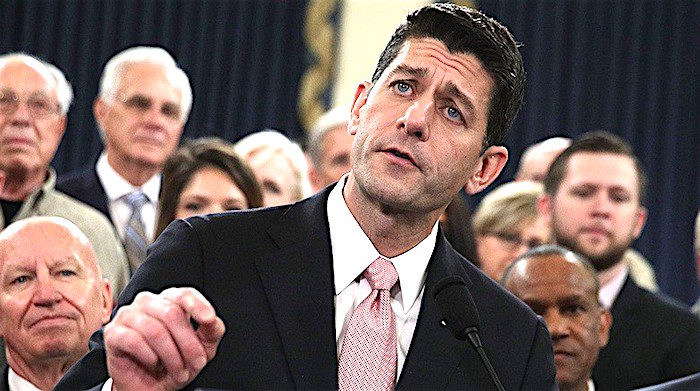
© static.politico
House Republicans claim the tax plan they introduced Thursday keeps the top individual rate unchanged at 39.6 percent-the level at which it's been capped for much of the past quarter-century. But a little-noticed provision effectively creates a new band in which income is taxed at over 45 percent.
Thanks to a quirky proposed surcharge,
Americans who earn more than $1 million in taxable income would trigger an extra 6 percent tax on the next $200,000 they earn-a complicated change that effectively creates a new, unannounced tax bracket of 45.6 percent.
It hasn't been advertised by Republicans, who have described their plan as maintaining the current top tax rate of 39.6 percent. And it goes against decades of GOP orthodoxy that raising taxes on the rich discourages work and reduces economic growth. Reached by phone, Steve Moore, a tax expert at The Heritage Foundation, said the surcharge was news to him. "I was just in a briefing with the White House on this," he said. "They didn't mention that. It seems kind of bizarre to me."
The new rate stems from a provision in the bill intended to help the government recover, from the very wealthy, some of the benefits that lower-income taxpayers enjoy. Under the House GOP plan, all individuals-no matter whether they earn $35,000, $150,000 or $10 million-would pay the lowest rate, 12 percent, on their first $45,000 in taxable income. That's a normal feature of current American tax law. But in the new plan, House Republicans want to claw back some of that benefit for individuals who earn more than $1 million, or couples earning more than $1.2 million.
Here's how it would work: After the first $1 million in taxable income, the government would impose a 6 percent surcharge on every dollar earned, until it made up for the tax benefits that the rich receive from the low tax rate on that first $45,000. That surcharge remains until the government has clawed back the full $12,420, which would occur at about $1.2 million in taxable income. At that point, the surcharge disappears and the top tax rate drops back to 39.6 percent.
This type of tax is sometimes called a "bubble tax," because the marginal tax rate effectively bubbles up for a brief period before falling back to a lower level.According to POLITICO's calculation,
the surcharge could raise more than $50 billion over a decade -- money that will help the GOP meet the $1.5 trillion in increased deficits that their budget allows for and required to balance out tax cuts elsewhere.
Balancing out those costs means that the bill can pass through budget reconciliation, and Senate Democrats can't filibuster the bill.Whom would it affect? According to the Internal Revenue Service, 438,000 tax filers had more than $1 million in taxable income in 2015, most of whom also make more than $1.2 million-meaning they'd pay the full additional $12,420 in bubble tax. Altogether, that surcharge could have raised roughly $5 billion in 2015, the latest year in which numbers are available, meaning it could potentially bring in around $50 billion over the next decade. That's not huge money in a plan that cuts taxes $1.5 trillion-but every bit counts.
A spokesperson for the House Ways and Means Committee did not dispute the math but characterized the bubble as "the phase-out of a tax benefit" for high earners, rather than a surcharge. "The Tax Cuts and Jobs Act provides tax relief at every income level," said the spokesperson.
The idea of a bubble tax is not exactly new. In fact,
the corporate tax code currently contains a bubble tax, which the GOP plan would eliminate. But the hidden nature of bubble taxes concerns experts who believe that the tax code should be easy to understand. "It certainly doesn't promote tax transparency in terms of letting people readily understand the true rate structure," said Alan Viard, a tax expert at the American Enterprise Institute. "I don't think many people in the tax policy community are enthused about this kind of provision."
The bubble tax also represents something of a break from nearly all Republican tax plans for the past few decades. Supply-side conservatives have long complained that the current tax rates on top earners are too high, discouraging work and reducing economic growth. House Republicans proposed lowering the top rate to 33 percent in the tax blueprint that they released last year.
Over the past few weeks, faced with pressure from President Donald Trump to counter critics who said the plan is a giveaway to the rich and needing additional revenue, GOP leaders acceded to leaving the top rate unchanged. For a party that has focused intently on lowering marginal tax rates, it was a big concession.
Reader Comments
to our Newsletter